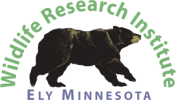Scarce Food, Visible Bears, Diversionary Feeding Being Tested - UPDATE July 22, 2020
 Shadow and Spanky
Shadow and Spanky
Despite recent rains, effects of the drought continue. A long-time blueberry picker reported that he picked for an hour in a location that is usually reliable and got only a cup. Bears in some areas are going house to house for food. But in Eagles Nest Township there is little of that while bears are being seen in unprecedented numbers at the diversionary feeding sites, showing that the sites are being effective again this year as in the past. Nothing is perfect. In bad food years, the occasional bear can resort to bird feeders or take advantage of other human food that is available, but for the most part the bears are going to the diversionary feeding sites as they have since such feeding began with Ed Orazem back in 1961. It continued and grew over the decades because it worked.I became aware of this nature-loving community in 1985 when I saw a newspaper article about Ed in the Ely Echo that began with “There have been a lot of problems with bears in and around Ely this year, tipping over garbage cans and getting into gardens, but south of town, on Armstrong Lake the bears just aren’t interested in causing problems. The main reason is that the bears are being served at an outdoor restaurant, owned and operated by Ed Orazem.” A picture showed Ed sitting next to one of the bears that had lost its fear of people. The article went on to tell how he began feeding bears. It worked, and he and others have continued feeding in Eagles Nest Township ever since. 1985 was the worst year in Minnesota history (to this day) for wild berry crop failures and number of nuisance complaints. Eagles Nest Township stood out for its lack of bear problems. That has continued to this day.
 RC
RC
In 1985, some 20 miles to the east, I was doing a diversionary feeding experiment (1984-1991) near the U.S. Forest Service Kawishiwi Campground with similar results. The feeding completely eliminated problems in 1985. Throughout the 8-year experiment, no bear that found the diversionary feeding site a quarter mile from the campground ever became a problem. The peer-reviewed study results can be seen at Rogers, L. L. 2011. Does diversionary feeding create nuisance bears and jeopardize public safety? Human-Wildlife Interactions. 5(2): 287-295. Click on the highlighted title to see the entire paper. In this USFS study around the Kawishiwi Campground, the feeding immediately drew bears away from the campground and adjacent residential area. Two bears that came into the periphery of the Kawishiwi study area 2 miles from the campground became pests and were removed; but overall during the study, problems were 88% lower than in the previous 3 years when 6 bears were removed for approaching people for food. No bear that found the feeding site became problems.
In 1996, when I began studying the effects of such feeding on the bears of Eagle Nest Township, bear problems in the township were 80% below the statewide average on a per-bear basis.
Regarding berry failures this year (2020), the food crisis was made worse near the town of Embarrass (15 miles southwest of Eagles Nest Township) by a frost on June 10 that Eagles Nest Township escaped. The Embarrass area is more low-lying and traditionally more susceptible to late spring frosts.
 Ruby-throated hummingbirdLocally, at a diversionary feeding site in Eagles Nest Township, 33-year-old Shadow made an appearance yesterday with her 5-year-old son Spanky, who was not accompanying her but close enough to be caught in the same picture. Shadow, in the lower left corner of the picture, shows her white face. She is the 2nd oldest black bear on record. Less than 200 yards away, her 21-year-old daughter RC was seen with her 4 cubs (two males, two females). I snapped a picture to record the amount of white on RC’s face, but the light was such that I couldn’t distinguish between glare and whiteness.
Ruby-throated hummingbirdLocally, at a diversionary feeding site in Eagles Nest Township, 33-year-old Shadow made an appearance yesterday with her 5-year-old son Spanky, who was not accompanying her but close enough to be caught in the same picture. Shadow, in the lower left corner of the picture, shows her white face. She is the 2nd oldest black bear on record. Less than 200 yards away, her 21-year-old daughter RC was seen with her 4 cubs (two males, two females). I snapped a picture to record the amount of white on RC’s face, but the light was such that I couldn’t distinguish between glare and whiteness.
A ruby-throated hummingbird posed for a picture but did not turn so the sun would light his red throat.
Thank you for all you do.
Lynn Rogers, Biologist, Wildlife Research Institute and North American Bear Center
